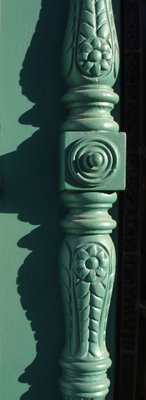Rose-coloured glasses.
In the painting one of my blogfriends loves best, Marc Chagall's "The Eiffel Tower" (1934), the sun always shines, and an angel always hangs and watches it.

A lot of today felt like being this angel, borne on by some clarity of heat and vision. I did look for grit, you my urban friends, but I don't think I have the eye for it. Instead, I kept finding urban flowers:

Now here's the punchline: One of the things I forgot to tell you about the National Gallery when I wrote about it the other day is that one of its paintings looks like a ghost. It's Joshua Reynolds's portrait of Colonel Charles Churchill, from about 1755. Churchill's face is chalky white because when he executed the portrait, Reynolds was experimenting with the fugitive color carmine. Apparently, Churchill wasn't the only of Reynolds's sitters who saw his painted face losing its color; the museum's wall plaque reports that when clients worried or complained, they were assured (by whom, the plaque doesn't say) that any painting by Reynolds--even a faded one--would be the best thing they could have. He was 32 when he painted Churchill's portrait.
The concept of the fugitive image has long been a favorite of mine. In the decade before Louis Daguerre and William Henry Fox Talbot (in France and England, respectively) figured out the correct fixative treatments, they were able to take photographs but couldn't keep them. These images are known as fugitives; they flee in the light. When you come across an early photograph in a museum exhibition and it's covered by a heavy dark cloth, it's a semi-fugitive image, one that, with too much more exposure, would simply disappear.
Those early images also had incredibly long exposure times; the first image historically recognized as a photograph, taken from Joseph Nicephore-Niépce's studio window, took eight hours to produce. My favorite photographic image of all time, Daguerre's 1839 picture of a Paris boulevard, didn't take eight hours, but it did take long enough to vacate a city street.

The only people who survived the passing of time here, thereby making it into the historical record, are the ones who were not themselves passing on to somewhere else while Daguerre let the sun do its work: a man having his boots cleaned and the man doing the cleaning, there on the corner. When an exposure time is this long, those who move swiftly enough simply disappear, become fugitive. Traversing a city alone feels like that for me: I start to seem insubstantial, to become an embodiment of the act of looking itself.
There's more to say; that could be my life's motto. More about Norval Morrisseau, for instance. And more about the experience of walking alone by a river just at the point where late afternoon becomes early evening--and especially about that experience for one who is still and always missing her beloved lake. But now it is time to sleep. Not having my hot milk here is one of many things that have thrown me off during this trip.


